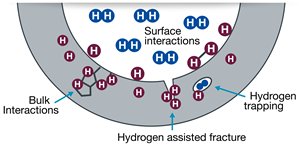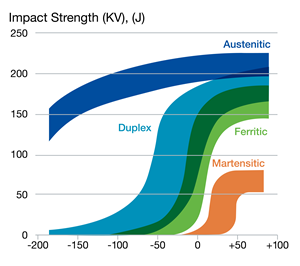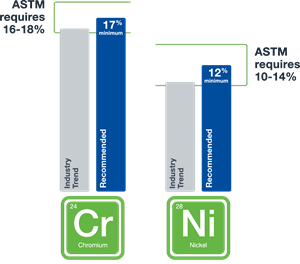News
Online Feature: Avoiding H2 embrittlement
H2 Equipment and Services
B. DAMM, Swagelok, Akron, Ohio
Science continues to search for suitable alternatives to power various applications. While reasons range from avoiding geopolitical conflicts to the urgent need to battle climate change, one idea is gaining traction: Hydrogen (H2) is a promising solution (FIG. 1). However, it presents unusual challenges concerning how best to handle this zero-emission fuel source because of its lightness and small molecule size.

If H2 is going to replace fossil fuels in transportation and other applications, companies must find ways to handle it in both its liquid and gaseous forms. H2 liquifies at −252.9°C (−423°F) and is about 140 times denser as a liquid than a gas. Transporting and storing it as a liquid is more efficient, but at its point of use, H2 is a gas. These characteristics can negatively affect metals in one of two ways:
- Low-temperature embrittlement: As temperature decreases, metals lose some ductility.
- H2 embrittlement: At higher temperatures where H2 is a gas, atomic H2 can diffuse into the metal and cause embrittlement.
When engineers discuss embrittlement, they mean that a metal’s ductility, fracture resistance and fatigue are significantly reduced due to the service setting’s environmental conditions compared to situations without those stressors. These reductions can cause system failure and put employees at risk, increase downtime and cost money. Preventing these problems will become paramount as the H2 industry grows in importance.
H2 professionals must find components for systems that can handle the gas’ volatile molecules. Specifically, they should use components that are designed for H2 systems and also made of high-quality stainless steel with higher nickel and chromium content. Such stainless steels are less likely to succumb to embrittlement and are more effective at keeping H2 where it is supposed to be.
How embrittlement happens. H2 molecules penetrate metals when stable H2 molecules devolve into atomic H2. Typically, they coalesce around stress concentrations like crack tips or microstructural features like grain boundaries, inclusions or precipitates (FIG. 2).

Low-temperature embrittlement occurs when temperatures fall precipitously and cause reductions in ductility, toughness or fatigue and facture resistance. Austenitic stainless steels hold up well under these conditions and suffer only minor damage. In comparison, ferritic steels suffer significantly more damage under the same conditions (FIG. 3). That is why austenitic stainless steels are most often used in liquid H2 systems where temperature fluctuations are likely.

On the other hand, H2 embrittlement occurs when molecules embed themselves in metals and reduce the fatigue and fracture resistance of the component. High-strength materials are far more susceptible to H2 embrittlement. Austenitic stainless steels are more suitable for these applications because of their face-centered cubic (FCC) crystal structure, moderate strength and naturally high ductility. However, that does not mean they are completely immune to H2 embrittlement, so they should be monitored accordingly.
Why more susceptible steels pose more problems. Since all forms of embrittlement make components and systems weaker, it is far more likely these systems will fail prematurely. Of the two most common weaknesses—loss of ductility and component fatigue—fatigue is far more serious. Well-designed components do not undergo the stresses that could result in macroscopic plastic deformation, so loss of ductility is minimal.
Cyclic loading, resulting from pressure cycling, vibration or other service loading, can cause damage over time and can cause components to fail from fatigue, which occurs when steel is weakened by repeated stresses or loadings. Additionally, components and systems under these stressors may be deployed under harsh environmental conditions that make fatigue failure even more likely over time. Component failure can lead to employee safety concerns, expensive downtime, additional maintenance, escaping H2, and an increased total cost of operation and ownership for the system.
How to determine the quality of your stainless steel. Testing has shown that stainless steels with higher levels of nickel and chromium resist H2 embrittlement more effectively than those with lower levels. The American Society for Testing and Materials (ASTM) requires a minimum of 10% nickel (Ni) in 316 stainless steel formulations, but 316 stainless steel with a minimum of 12% nickel is better for the unique challenges posed by H2 (FIG. 4). Nickel content helps stabilize the microstructure of stainless steel, enabling it to be more resistant to H2 embrittlement. In testing performed by the author’s company, they found H2 embrittlement’s effect on tensile ductility in 316 stainless steel with 12% Ni content to be minor.

For most H2 systems, higher nickel content components are the most logical choice for H2 systems, but sometimes other performance criteria require choosing a different material. For example, if material strength or corrosion resistance takes precedence over preventing embrittlement, then other materials may make more sense. In those instances, it becomes even more critical to design systems properly to deter embrittlement. As more research about the mechanisms of embrittlement becomes available, a reliable supplier should be able to help guide which components make the most sense for particular applications.
Why high-performance matters in H2 valves. H2 fuel systems are composed of many valves, which means understanding how to specify them is essential. When system engineers write specifications for these systems, they should consider these factors before making valve decisions:
- Pressures
- Stress and vibration
- Safety
- Maintenance.
Valves that do not meet the highest standards in these four categories should not be deployed. Additionally, suppliers should demonstrate the leak-tight performance at connection points, shutoffs, or regulation points, and that their components will be able to withstand the most rigorous conditions found in H2 applications. The three most common valves used in H2 systems include:
Ball valves. For H2 applications, ball valves should contain wear-resistant stem seal designs. It may make sense to use trunnion-style balls with direct-load designs, which provide the necessary leak-tight performance. As an alternative, bottom-loaded stem designs can also prevent stem blowouts and make the system safer. If there are questions about which valve best fits an application, a reputable valve supplier should be able to guide those decisions.
Needle valves. Most H2 applications take tolls on needle valves because of the immense force necessary to open and close them. Since they are typically all-metal valves, repetitive force applications can deform the needles and lead to leaks and expensive maintenance. When selecting needle valves for H2 applications, they should be made of high-quality 316 stainless steel, which will not deform as easily under force. Furthermore, H2 needle valves should be properly pressure-rated to handle these pressures (usually 350 bar/700 bar).
Check valves. In H2 refueling systems, check valves typically prevent backflow as end users fuel their vehicles. This safety function is essential and must not be overlooked. Check valves often contain springs that are strain hardened, which makes them particularly susceptible to H2 embrittlement. Check valves should be made with high-quality 316 stainless steel and must be able to withstand significant, sudden pressure and temperature changes. Typically, ball check valves work best in H2 systems.
Choose high-performance materials carefully. Without guidance from a respected supplier, it may be difficult to determine which materials will work best in specific applications—but making the right decisions is paramount, particularly when dealing with H2 applications. If H2 is to replace fossil fuels as a reliable and viable fuel source, the systems designed to handle it must be of the highest quality.
Find suppliers who understand not only material science but the specific requirements of H2 applications. Their knowledgeable, experienced advice should pave the way to finding the optimal materials and best solutions that will meet an application’s specific needs.
About the author
BUDDY DAMM is a Senior Scientist, Metallurgy for Swagelok Company.

